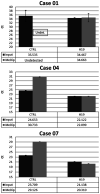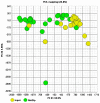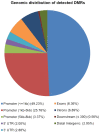DNA methylation variations in familial female and male breast cancer
- PMID: 33907578
- PMCID: PMC8063268
- DOI: 10.3892/ol.2021.12729
DNA methylation variations in familial female and male breast cancer
Abstract
In total, ~25% of familial breast cancer (BC) is attributed to germline mutations of the BRCA1 and BRCA2 genes, while the rest of the cases are included in the BRCAX group. BC is also known to affect men, with a worldwide incidence of 1%. Epigenetic alterations, including DNA methylation, have been rarely studied in male breast cancer (MBC) on a genome-wide level. The aim of the present study was to examine the global DNA methylation profiles of patients with BC to identify differences between familial female breast cancer (FBC) and MBC, and according to BRCA1, BRCA2 or BRCAX mutation status. The genomic DNA of formalin-fixed paraffin-embedded tissues from 17 women and 7 men with BC was subjected to methylated DNA immunoprecipitation and hybridized on human promoter microarrays. The comparison between FBC and MBC revealed 2,846 significant differentially methylated regions corresponding to 2,486 annotated genes. Gene Ontology enrichment analysis revealed molecular function terms, such as the GTPase superfamily genes (particularly the GTPase Rho GAP/GEF and GTPase RAB), and cellular component terms associated with cytoskeletal architecture, such as 'cytoskeletal part', 'keratin filament' and 'intermediate filament'. When only FBC was considered, several cancer-associated pathways were among the most enriched KEGG pathways of differentially methylated genes when the BRCA2 group was compared with the BRCAX or BRCA1+BRCAX groups. The comparison between the BRCA1 and BRCA2+BRCAX groups comprised the molecular function term 'cytoskeletal protein binding'. Finally, the functional annotation of differentially methylated genes between the BRCAX and BRCA1+BRCA2 groups indicated that the most enriched molecular function terms were associated with GTPase activity. In conclusion, to the best of our knowledge, the present study was the first to compare the global DNA methylation profile of familial FBC and MBC. The results may provide useful insights into the epigenomic subtyping of BC and shed light on a possible novel molecular mechanism underlying BC carcinogenesis.
Keywords: DNA methylation; Gene Ontology; epigenomics; female breast cancer; male breast cancer; methylated DNA immunoprecipitation on chip.
Copyright: © Abeni et al.
Conflict of interest statement
The authors declare that they have no competing interests.
Figures





References
LinkOut - more resources
Full Text Sources
Other Literature Sources
Miscellaneous
